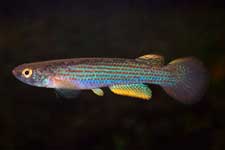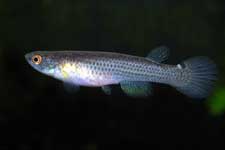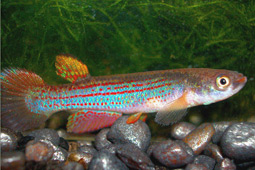History
Alternative name Anablepsoides limoncochae.
The type locality of Rivulus limoncochae is situated in Eastern Ecuador, a small brook emptying into the lake Limoncocha (= Limon lake) part of the Rio Napo River system. (0°24'25.48"S 76°37'12.77"W)
The species was discovered by Dr. Erhard Roloff June 1961 and described by Hoedeman in 1962. The types are deposited at ZMA, the Amsterdam museum (now transferred to the Leiden museum Naturalis, The Netherlands).
The species is closely related to Rivulus rubroliniatus and/or Rivulus iridescens and reported also from the far north-east situated small town Puerto Lopez, Rio Metica, a tributary to the upper Rio Meta that is part of the Orinoco river system in Colombia and Venezuela. This however this is a doubtful report and future investigation is needed to clear this remarkable finding.
Berkenkamp (1989) gives a redescription of the species but the findings in his paper were not based on the type specimen (according Wildekamp) but on samples of other locations including the one in Colombia. Those samples show the dorsal behind the anal, unlike in Rivulus limoncochae described by the original description of Hoedemann and the close related Rivulus rubrolineatus and Rivulus iridiscens also known from Ecuador and Peru.
Reproduction
Keeping and breeding is easy but a good cover of the aquarium is necessary because there ability to jump, even true the smallest opening, is unbelievable.
This species can, if there is enough space for them, housed in a tank with more males than one only and several females. If separated before and brought together again however, they can be very agressive to each other and fight to become dominant to others. The best way to have much offspring is to put a pair or an trio in a small tank from 10 liters with a small filter in it or with some airation. On the bottom some peat moss or dark gravel and a floating "mop" to give space for laying there eggs. The fish will, if they become a rich varity of life food, spawn during there whole adult life and produce daily between 5 to 15 eggs.
The eggs should be collected by hand and stored for about 14 days in a small container. Eggs are 1.6 mm and amber colored. It is wise, to add to the water you store the eggs in, some acryflavine to provent fungus coming up.
After hatching the young fry can eat fresh artemia nauplii without any problem. It takes 4 to 5 months to raise them to maturity. Often the number of males is far above the number of females. For some species this can become a major problem for the breeder as he has to raise many young fishes and so become able to distribute a few pairs to other hobbyists. Recent personal tests laerned that lower pH levels during the time of hatching gave a higher percentage of females. To achieve this I use some peat moss that I add to the container with the egss just before they are ready to hatch. This peat moss also is a good way to prevent eggs to become attact by fungusses.
There lifespan can be up to 3 years in captivity.
Remarks :
Variations
Map
Meristics
Max. size 7.5 cm.
Dorsal 9.0,
Anal 15.0,
D/A 11.0,
LL scale count (average)41.0
Pre- dorsal length to % SL – 77.0 %
Depth to % SL – 20.1 %
Literature
Hoedeman, J.J. 1962. Studies on Cyprinodontiform Fishes. A new Species of the Genus Rivulus from Equador with additional Records of Rivulus from the upper Amazon and Ucayali Rivers. Beaufortia, 9 (103): 146, fig. 2.


